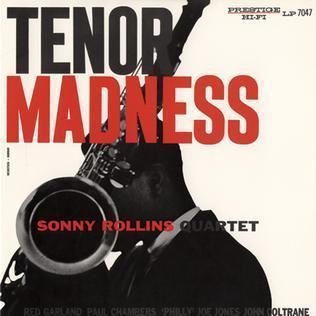Released 1956 Release date 1956 | Length 35:24 | |
 | ||
Recorded May 24, 1956Van Gelder Studio, Hackensack Similar Saxophone Colossus, Work Time, Way Out West, Moving Out, Sonny Rollins Plus 4 | ||
Sonny rollins quartet with john coltrane tenor madness
Tenor Madness is a jazz album by Sonny Rollins. It is most notable for its title track, the only known recording featuring both Rollins and John Coltrane.
Contents
- Sonny rollins quartet with john coltrane tenor madness
- Tenor madness sonny rollins solo bass
- History
- Reception
- Track listing
- Personnel
- Songs
- References
Tenor madness sonny rollins solo bass
History
Rollins and Coltrane had both been members of groups with Miles Davis and Thelonious Monk in the past. Rollins had had some recent success, and both were emerging as prominent solo tenor saxophone players. Two months prior to the session for Tenor Madness Rollins was working at Rudy Van Gelder's studio in New Jersey on the album Sonny Rollins Plus 4 with Max Roach and Clifford Brown. And two weeks before, on May 11, Coltrane, Red Garland, Paul Chambers, and Philly Joe Jones, had been recording with Davis at the same studio to fulfill his duties for Prestige, sessions that would later go on to provide material for the albums Workin', Relaxin', and Steamin' with the Miles Davis Quintet.
Although the rhythm section's “playing here is somewhat less vital than on that session” (with Davis), the historical importance of Tenor Madness lies in the title track. It is the only existing recording with Rollins and Coltrane playing together.
The title track is a twelve-minute duet between Rollins and Coltrane, and the B-flat blues melody has become very well known for Rollins. The tune was first recorded in 1946 by Kenny Clarke and His 52nd Street Boys as "Royal Roost", and has also been recorded under the title "Rue Chaptal." "Royal Roost" is usually credited as a Kenny Clarke composition; as "Tenor Madness," it was credited to Sonny Rollins. It is easy to distinguish between the two saxophonists on the track "Tenor Madness", as Coltrane has a much brighter and more boisterous sound as compared to Rollins' smoother, "wet-reed" tone. However, as jazz critic Dan Krow said, the two complement each other, and the track does not sound like a competition between the two rising saxophonists.
"Paul's Pal", a jumpy swing track, is a Rollins composition, named for bassist Paul Chambers. "When Your Lover Has Gone" is a 1931 composition by Einar Aaron Swan, re-interpreted here as a drum-driven blues track. The Clinton & Debussy ballad "My Reverie" is one of Rollins' most prominent examples of his lyrical skills from his 1950s' recordings. "The Most Beautiful Girl in the World", a tune from the 1935 musical Jumbo, is a Rodgers & Hart composition which goes here from a jazz waltz to a fast-paced 4/4 tune.
Reception
The Allmusic review by Michael G. Nastos calls the album "A recording that should stand proudly alongside Saxophone Colossus as some of the best work of Sonny Rollins in his early years, it's also a testament to the validity, vibrancy, and depth of modern jazz in the post-World War era. It belongs on everybody's shelf". Author and musician Peter Niklas Wilson called it "one of the most famous combo recordings of the 1950s"
Track listing
All tracks by Sonny Rollins except where noted.
- "Tenor Madness" - 12:16
- "When Your Lover Has Gone" (Einar Aaron Swan) - 6:11
- "Paul's Pal" - 5:12
- "My Reverie" (Larry Clinton, Debussy) - 6:08
- "The Most Beautiful Girl in the World" (Rodgers, Hart) - 5:37
Personnel
Songs
1Tenor MadnessSonny Rollins Quartet12:16
2When Your Lover Has GoneSonny Rollins Quartet6:13
3Paul's PalSonny Rollins Quartet5:12
